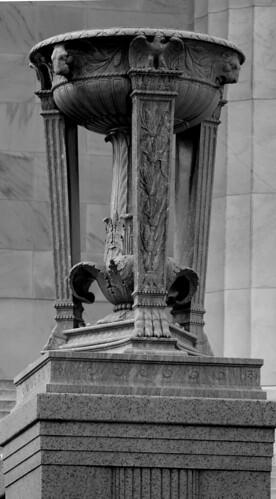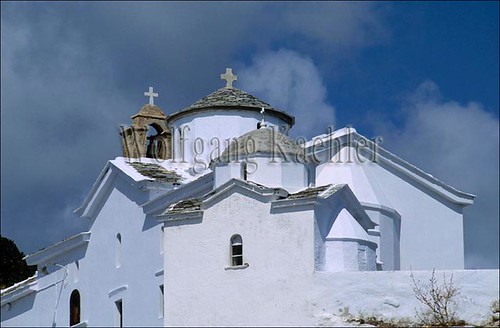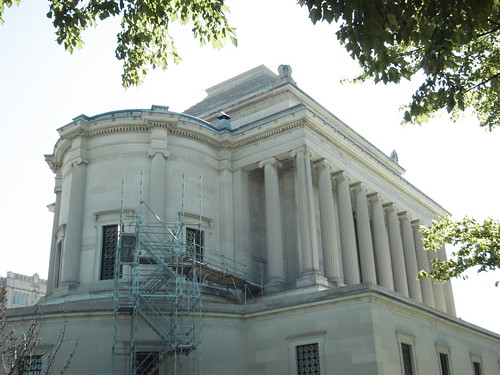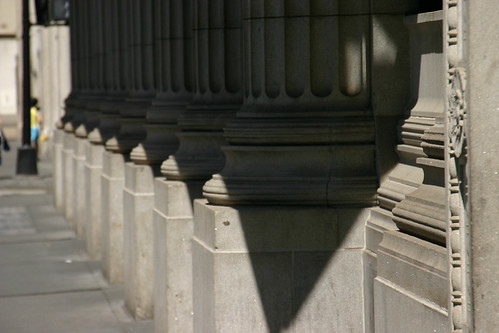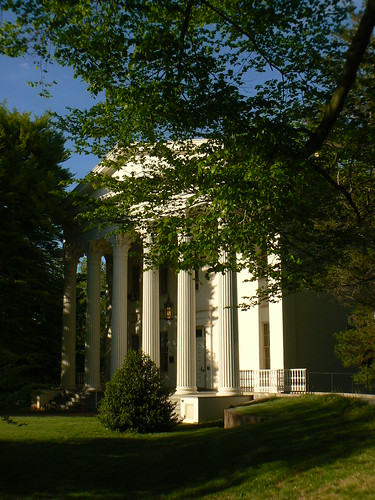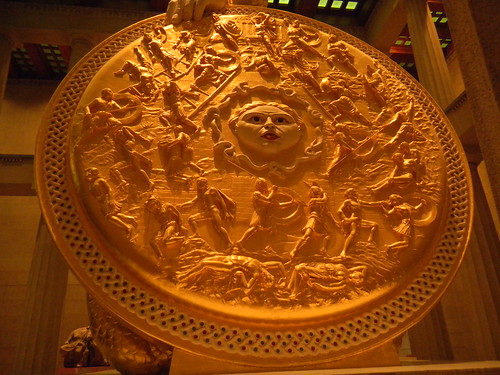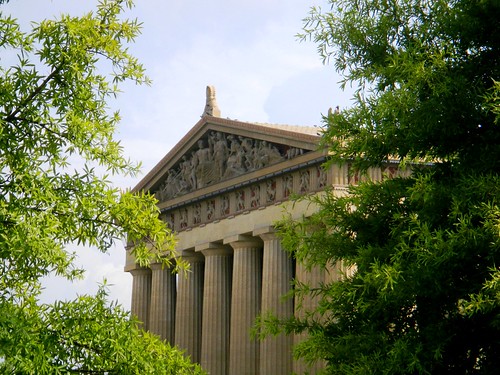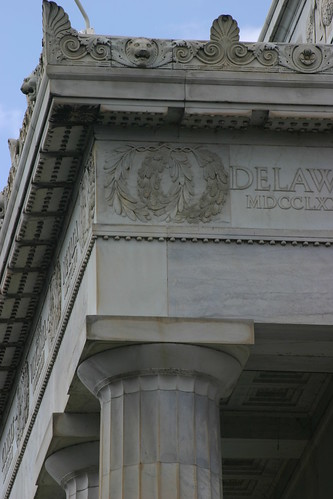
Image : http://www.flickr.com
Looking at the altar now overgrown with weeds in the theatre of Dionysus, one cannot but reflect on how the theatre evolved from a rural troop expressing primitive desires into an expression of the mind. There was a sanctuary of Dionysus on this side of the Acropolis since the time when his cult began to spread.
Pausanias spoke of a Delphic oracle which compelled the reluctant Athenians to accept this foreign god and that it was a zealous priest from Erythres who brought in the first cult statue. Erythres was situated at the point where one crossed from Boeotia into Attica, at the foot of Mt Cithaeron, in present day Kaza. Knowing that the Dionysiac cult reached its peak in Thebes with orgiastic rituals, we can understand the reason why this sacred idol came from there. It is very likely that there was a circular area with an altar situated beside a 6th century temple and used for some early type of performance.
There was also a large round orchestra in the Agora area where, in about 495 BC, during a theatrical contest between Choirilos, Pratinas and Aeschylus, the wooden benches collapsed, killing many spectators. It was then decided to build a more permanent structure. Scholars still disagree about when the theatre of Dionysus was built, because whatever has survived up to our time belongs to various ages. Construction of some kind continued on this site for many centuries. Excavations have shown that the 6th century orchestra was added to an auditorium with lateral retaining walls, which show 5th century construction details. But no trace of permanent seats have been found from that period.
A Doric temple was built in the 4th century to house the gold and ivory statue of Dionysus that Pausanias later saw. The remains of this temple with its magnificent masonry is the first thing we see upon entering the present archaeological site. There was also a wall supporting the earth on the side of the orchestra, which together with the natural slope of the round, created an extended Doric portico near the older archaic temple. In 430 BC, the Athenian orator Lykourgos built the stone seats, saw to the drainage of the rain water and planned the construction of a square building, behind the circular orchestra and higher than it, which had small porticoes near the side entrances: it was the logeio, the first speaking place for the actors.
Later, during the rule of Nero, the stage was raised even higher, and the wall of the logeio was ornamented with statues which can still be seen today. It was then that the orchestra took on its present shape, i.e. 2/3 of the initial circle, with a diameter of almost 20 m, and was paved with marble slabs. Also, during the years of Roman rule, a low stone dividing wall was built over the drainage gutter. Even later, in the 3rd century AD, a certain Phaedros built a new stage, since the theatre was used for various assemblies, as indicated by an inscription on the speaker's podium.
The theatre could hold about 20,000 spectators. In its final form, the lower section had 13 wedge-shaped sections separated by stairways, steps, and 32 rows of seats radiating out around the orchestra. The upper diazoma had another 32 rows of seats, which covered only the centre, since on one side, the Odeion of Pericles abutted onto it and on the other, the natural rock restricted the extent of the auditorium. Later a third section was added, especially for foreigners, increasing the number of rows to a total of 78. Today only 25 of them have been preserved. The material used to build them was Piraeus limestone, with the exception of the 67 officials' thrones in the first row, which were built of white Pentelic marble.
The inscriptions inform us that 45 of these thrones belonged to the elected priests. The others were intended for distinguished citizens, benefactors, local archons, and even orphaned children whose fathers had fallen in war and whom the state wished to honour. Somewhere in the first rows must have been the seats of the critics for the tragedy contests during the Dionysian feasts. During the years of Roman rule, thrones were added for officials of the conquerors, with a special place for the throne of the Hellenist Hadrian in a prominent position.
The most impressive seat was certainly the one bearing the inscription PRIEST OF DIONYSUS ELEFTHERIOS which we can still see facing the altar. This marble throne rests on lion's feet and has bas relief sculpture on its back which depict two strong satyrs carrying an enormous bunch of grapes, the sacred symbol of the god. While all the other seats have a simple rounded line, this one is an imposing throne with arm rests and sculptured decoration of winged human forms. The front of the seat shows griffins and men wearing Eastern dress, perhaps an allusion to the origin of the god.
All this luxury showed how important was the priest of Dionysus Eleutherios who, seated in a place of honour, would watch the performances that constituted a spiritual libation to the god he served. The thrones of the Archon General and the Herald, high officials in the Athenian hierarchy, were right behind the position of the Dionysian priests, stressing the latter's importance even more.
On the side of the stage, construction works were carried out at different epochs owing to the constant changes and use of older materials in subsequent buildings. Archaeologists believe that the stage was built in the first century AD and that the sculptured decoration on the facade of the platform may very possibly have been taken from some other monument on the site and been placed there in some architectural arrangements. These sculptures depict scenes from the myth of Dionysus: a man, perhaps Theseus, and a woman carrying a horn of plenty are welcoming the young god; on the other side Dionysus is shown seated on a luxurious throne similar to that of his priest, while behind him the Parthenon is faintly visible. Most impressive of all is the mature kneeling satyr who, in the position of Atlas, holds the proscenium on his back. When the theatre was excavated, all the sculpted figures on the logeio were covered with a thick layer of plaster which was cleared off in 1862.
The astonished archaeologists realised then that this inexplicable layer was the solution found by some Roman official, with the delicacy of a legionary, to create a closed space in the orchestra which could be filled with water for the representations of naval battles. Apart from this extreme lapse of artistic appreciation, there were also splendid examples of people who contributed to the area, such as the Emperor Hadrian. When Hadrian came to Athens, where he had studied, he gave the order that gladiators' contests be forbidden and such spectacles which had been imposed on the Athenians by his predecessors be banned.
On the east side of the theatre was the Odeion of Pericles, which has yet to be excavated fully. Plutarch mentioned it in his Lives as a large square building with many interior columns supporting the conic wooden roof. This strange edifice was built in the 5th century under the personal supervision of the great Athenian politician and owes its shape to Xerxes' tent which was left behind after the battle of Salamis. In this way Pericles wanted to remind the Athenians of their amazing victory over the Persians and, at the same time, to have a venue for the musical contests held during the Panathenaia which he himself had established. But since the Athenians preferred open spaces for events of all kinds, this odeion came gradually to be used only for try-outs for contests and rehearsals of theatrical works. It was destroyed by fire in the 1st century, when Sulla occupied Athens, but Pausanias reported that it had been rebuilt. Today we can only see part of one side which was hewn out of the rock, occupying part of the upper diazoma of the theatre of Dionysus.
Above Pericles' Odeion and above this upper diazoma of the Theatre of Dionysus, was the Peripatos, a path around the sacred rock and a place for people to spend their leisure time. An inscription carved onto the rocky northeastern surface provides us with information about its name and length. It was about one kilometre long, starting out where the Panathenaic Way ended at the entrance to the Acropolis. It wound past by the Klepsydra spring, the sanctuary of Pan on the north side, the sanctuary of Aphrodite, and the ancient Mycenean stairway which led to another spring. Turning the eastern corner of the rock, the path wended westward above Pericles' odeion and was used for access to the upper tiers in the theatre of Dionysus. It then sloped slightly down toward the sanctuary of Asclepius and then rose again to the foot of the rock, up toward the entrance to the Acropolis. Thus Athenians could walk on either the sunny or shady side of their religious centre.
The most important road in the region was unquestionably Tripodon Street, which started out from the Agora, ended at the Theatre of Dionysus, and was used for festive processions. This broad (6 m. width) and heavily frequented road took its name from the monuments built to house the tripods by which the state honoured sponsors of theatrical performances. Pausanias said that it was not only the monuments that were remarkable, but also the works of art frequently kept inside them. As an example he referred to the Satyr which Praxiteles regarded as one of his best works. It was said that, for her services, the courtesan Phryne had asked the great sculptor to give her whatever work he considered to be his best. But the artist said nothing. Then the clever beauty pretended that the sculptor's workshop had caught fire, and when the frantic Praxiteles exclaimed that if his works the Satyr and Eros burned he would be truly destroyed, everybody realized that he had evaluated his own work. Phryne ultimately chose the statue of Eros for obvious reasons.
Present-day Tripodon Street crosses half the Plaka, whereas the ancient street of the same name is now buried a few metres underground, right below it. The foundations of some new houses, after 1950, revealed the width of the initial street and the pedastals of four choragic monuments, in addition to that which was built in 334 BC to hold on its conic roof the tripod won by the Athenian sponsor Lysikratis. Built in the form of a little cylindrical temple, the most elegant expression of the architecture of the times, this monument has survived through the centuries almost intact. On a heavy square base three m. deep rests a round crepidoma with three steps. On it stands a little marble temple with Corinthian columns three and a half m. high. The architrave is adorned with a narrow frieze of bas-relief sculpture depicting Dionysus' adventures with the pirates. On the dome, there was a triangular Corinthian column which supported the victor's tripod. On the eastern side was the inscription with the name of the sponsor, obviously visible to passers-by.
This marvellous monument has gone through many adventures and name-changes; most Athenians still know it as Diogenes' Lamp. In 1669, it was purchased together with a plot of land by the Capuchin monks who incorporated it into their monastery, first as a chapel and later as a library. That was when it acquired the name Demosthenes' Lamp since its floral crest struck them as resembling the base of a lamp. Demosthenes was just a memory retained by the people. A passing priest testified that it had been the office of Lord Byron, who we know passed through Athens just before the War of Independence broke out in 1821, and that he stayed in the nearby house of the widow Makri. It would appear that this charming structure offered him refuge when he wanted to write poetry, like the lines dedicated to the Fair Maid of Athens. The double name of the monument, Demosthenes and Diogenes, may possibly mean that there was another similar monument in the vicinity, as yet unknown, since the district still conceals many secrets relatively close to the surface of present day roads.
Perhaps the most original of the choragic monuments is that of Thrasyllos of Dekeleia, who won a tripod in the 4th century. Selecting a natural cave right above the theatre of Dionysus, he had the rough rock smoothed down and created an opening about 6 meters wide which he closed with a double- leafed door. On the upper part of the monumental portal, a space was levelled off to receive the honorary tripod. No better place could be found to show off his prize, and for this reason, when Thrasyllos' son Thrasykles, won a choragic award fifty years later, he set his tripod in the same position. Above the cave we can still see other choragic monuments consisting of unfluted columns with triangular Corinthian capitals, built especially to support tripods. This seems to have been was the most popular spot judging from the niches in the rock, perhaps to hold more monuments, and a marble sun dial. The monument of Thrasyllos has come down to us today as a chapel, because the local people dedicated the cave to the Panaghia Chrysospeliotissa (Blessed Virgin of the Golden Cave).
At the foot of the Acropolis, right next to the Theatre of Dionysus, there was another natural cave with a spring from which bubbled forth a small but constant stream of water. In antiquity, this spring was the reason for the site being dedicated to the healing god Asclepius.
In mythologies all over the world, water is regarded as being the principle of life. The Babylonians believed that the universe was created by the union of fresh and salt water and in China the green dragon which brought the waters was the positive male element, Yang. Among the Sumerians, the god of water was called Enki, which means "Master of the Earth" and in Iran the goddess of fertility was Anahita, "the Mistress of the Springs" who is still revered among Zoroastrians. The Aztecs called the god of rain Tlaloc, the terrible, "Flesh of the Earth" whose likeness was found in shrines. Germanic tribes considered the fountain Mimir as the font of all wisdom and Odin, god of war, sacrificed one of his eyes in order to drink of this miraculous water. Among the Indian Bedes, water was regarded as being of dual substance because it destroys by flood and regenerates by growth, but it also heals because it cleanses, washing away whatever is unclean. Equally healing is the water from the spring of Shiloe in the Scriptures.
In antiquity, there were references to purifying baths, in the same way as Saint John later baptized converts. And let us not forget the timeless dream of humans to find the "elixir of life"; the same sources are references to life which rush forth wherever and whenever they want, like uncontrolled mobile presences. The Greeks called springs "nymphs", gave them forms that were fair and fluid like running water, and had them living in damp caves, thus making the very ancient association of water-semen with cave-womb in the creation of life. On the slopes of the Acropolis, there were at least two sanctuaries dedicated to local nymphs, suggesting at the same time also the existence of subterranean rivers. One of these springs was granted to the healing Asclepius when his cult was established in Attica in the 5th century.
Very possibly born a mortal, Asclepius was deified in the classical years in Epidaurus, where the best known of his sanctuaries was located. In myth, he was the son of Apollo, from whom he inherited the ability to heal. His shrines, the Asclepia, were the hospitals of antiquity where human pain received comfort. On the south side of the Acropolis, a natural cave was hollowed out to make a circular area in which patients were bathed before being led to the sleeping room. There at night in their sleep, the god would appear to each one and give them instructions about curing themselves, uttered through the mouths of priest-healers and early psychologists, since the medicine of the times was based primarily on autosuggestion and practical prescriptions. The sleeping room was built in the form of a two-storey portico in front of which there was an open space for a small temple and an altar to the god while other buildings were added later, as the cult gained followers. With the advent of Christianity, the water of the springs was regarded as being blessed, and thus a church of impressive dimensions was soon built on the site of the ancient sanctuaries. Even today the cave is a chapel, and its entrance, with its well-preserved ancient walls, bears witness to the timelessness of hope.
The Asclepeion opened onto the Peripatos which passed right in front of it. In the 2nd century BC, Eumenes, king of Pergamon, built a grand colonnade with 64 Doric columns which started out at the side of the theatre and continued in a westerly direction serving at the same time to support the Peripatos. Very few of the columns in the stoa have been preserved, but the two-storey retaining wall of the Peripatos was preserved fairly well. For the spactators of Dionysian theatre, this meeting place must have been especially popular; thus when Herod Atticus built his own Odeion west of it in the 2nd century AD, he incorporated the Stoa of Eumenes in it as an access to the new building.
Herod Atticus was born in Marathon of a noble family; he was well educated and went on to become a famous orator. Much favoured by the Emperor Hadrian, he was granted significant public offices up to the rank of consul, causing the Athenians to regard him as being the Romans' man. Since he was very rich, Herod was able to offer public buildings to his fellow citizens. In addition to the beautiful villa he built in Kifissia, he remarbled the Athens Stadium on the banks of the Ilissos river and had a bridge constructed over the same river which was still in existence until the end of the 18th century. But his masterpiece was the Odeion, dedicated to his wife Regilla, a work which cost an enormous sum of money owing to the selected materials used to construct it.
The outer three-storey facade of the Odeion was almost thirty metres high, built with carefully quarried large rocks and arched openings which showed that it was the continuation of the older Stoa of Eumenes, thus stressing the natural rock of the Acropolis and the magnificence of the Parthenon at its peak. The interior was in the shape of a smaller Roman theatre, with a stage surrounded by walls on three sides, obviously for acoustic reasons. There were five sections in the lower diazoma and 10 in the upper one, with broad marble benches. The orchestra was confined to a paved semi-circle with steps leading up onto the stage, which had a very luxurious wall construction with openings on two sides and arched decorative niches. But the wonderful thing about this building was that the roof was constructed of cedar wood. The Odeion had a capacity of about 6000 spectators and was in use up to the 3rd century AD, at which time the inhabitants used its building materials for the hasty construction of fortification works. From that time until the last century, its role in the architectural history of the city was insignificant since, because of its position near the ramparts of the Acropolis, it was covered over. A traveller in 1819 mentioned that there were only two sections of seats visible. The Odeion was cleared of earth after the Greek War of Independence and restored both outside and in. After many centuries of abandonment, it has now been turned over to artistic events.
Go through this Athens Guide and learn more about Ancient Greece and Greece in general.
Hello world!
My name is Stella and I live in Greece. Travelling is my passion, learning new things is my vice and meeting new people my need! My goal here is to share with you my experiences and inspirations. I hope you enjoy this as much as I do!


